|
|||||||||||||||||||||||||||||||||||||
|
|||||||||||||||||||||||||||||||||||||
|
|
|||||||||||||||||||||||||||||||||||||
|
|||||||||||||||||||||||||||||||||||||
|
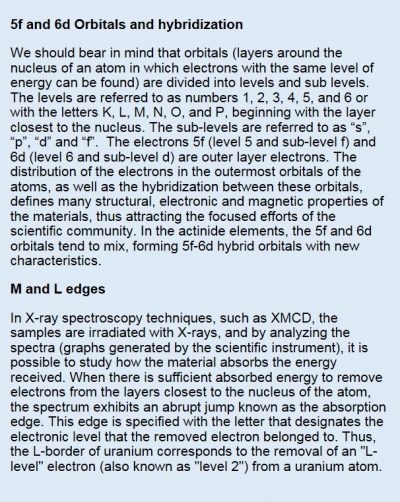 A team led by researchers from Brazil was able to unveil details of the distribution of electrons in materials based on actinide elements (the 15 chemical radioactive elements, with atomic numbers ranging from 89 to 103).
A team led by researchers from Brazil was able to unveil details of the distribution of electrons in materials based on actinide elements (the 15 chemical radioactive elements, with atomic numbers ranging from 89 to 103).
The group of scientists developed an experimental method that allowed a unique probing of the 5f and 6d orbitals and their hybridization in materials based on uranium (one of the most abundant actinide elements in the earth’s crust). This allowed the team to demonstrate, for example, that 5f-6d hybridization determines the magnetic properties of the studied materials. The work left as a legacy an experimental system for research on various magnetic materials (3d metals, rare earths, actinides and others), available to be used by the international scientific community at the Brazilian Synchrotron Light Laboratory (LNLS).
The study was reported in a paper that was recently published in Nature Communications (Impact Factor 12,124). “In this paper, we demonstrate the use of magnetic circular dichroism (XMCD) on the L-border of uranium to directly probe the 6d and 5f orbitals and also their degree of hybridization, rather than just probing the 5f orbitals as for instance the actinides M absorption edges,” details the corresponding author of the paper, Narcizo Marques de Souza Neto, professor at UNICAMP and researcher at LNLS.
In order to probe the orbitals of the uranium compounds, especially UCu2Si2 and UMn2Si2, the scientists had to overcome the difficulties of manipulating the materials due to their toxicity. They also had to make a series of adjustments in the high-energy XMCD technique to improve its sensitivity (to extend its detection limits).
These developments were initially performed at the LNLS DXAS line, dedicated to X-ray absorption techniques. Currently, the XMCD instrumentation is part of the XDS line of LNLS which is dedicated to X-ray diffraction and spectroscopy, where it is being used and improved. In the future the technique will be available in Sirius (the latest generation of synchrotron light source which is being built in Campinas), more precisely in the EMA line, which will be dedicated to X-ray techniques under extreme conditions of pressure and temperature. According to Souza-Neto, who coordinates both the XDS line and the EMA project, the conditions for studying actinides and similar materials by XMCD will be unparalleled in Sirius.
In addition to advancing the knowledge on actinides, the research demonstrated the potential of the XMCD technique improved by the Brazilian team to continue unveiling the characteristics of these still experimentally understudied elements. A deeper understanding of actinides, says Souza-Neto, is necessary to propose new uses for these elements, and also to be able to use them more efficiently in existing applications, such as, for example, power generation, diagnosis and treatment of diseases and the production of special glasses.
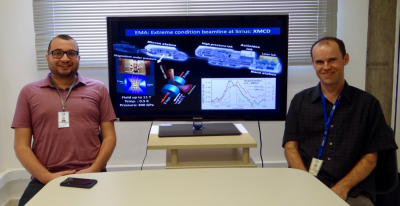
The history behind this work
The origin of this work dates back to 2009, when Souza-Neto was studying rare earth electronic structure and magnetism during his postdoctoral fellowship at the Argonne National Laboratory in the United States. “I had the idea of expanding the study of rare earths to actinide compounds (Souza-Neto et al., Phys. Rev. Lett., 102, 057206 (2009)) using XMCD to probe a charge transfer in the 4f and 5d orbitals”, the researcher reports. Looking for materials with similar characteristics, he came across uranium compounds. “We first tried to start this study in Argonne, but the conditions there to carry this out were not as we had hoped,” he adds. He returned to Brazil in 2010 as a researcher of CNPEM, with the desire to continue this initiative. Thus, in 2011, Souza-Neto began to guide the doctoral research of Ricardo Donizeth dos Reis on this subject together with the co-supervisor Flávio César Guimarães Gandra, a professor at Unicamp, with whom he had previously collaborated.
Samples of uranium compounds were prepared and characterized in the Laboratory of Metals and Alloys of Unicamp, coordinated by Professor Gandra, where there was already research experience on actinide and rare earth materials. The X-ray absorption spectroscopy experiments were performed at Argonne’s Advanced Photon Source and at LNLS. “All experiments on the L edges of uranium, which make up the main innovative contribution of this work, were carried out at LNLS,” Souza-Neto details. “At Argonne the experiments were carried out on the M edge of uranium to probe the contribution of the 5f orbitals separately and corroborate our interpretation of the results,” he adds. Furthermore, the Brazilian group had the participation of a researcher from France in the theoretical simulations performed for interpreting the data.
The research was carried out with financial resources from the São Paulo Research Foundation; from the Brazilian federal agency Capes; from the Ministry of Science, Technology and Innovation of Brazil, and from the Office of Science of the United States Department of Energy.
Scientific paper:
“Unraveling 5f-6dhybridization in uraniumcompounds via spin-resolved L-edge spectroscopy”. R. D. dos Reis, L. S. I. Veiga, C. A. Escanhoela Jr., J. C. Lang, Y. Joly, F. G. Gandra, D. Haskel & N. M. Souza-Neto. Nature Communications 8:1203 (2017). DOI: 10.1038/s41467-017-01524-1. Link: https://www.nature.com/articles/s41467-017-01524-1
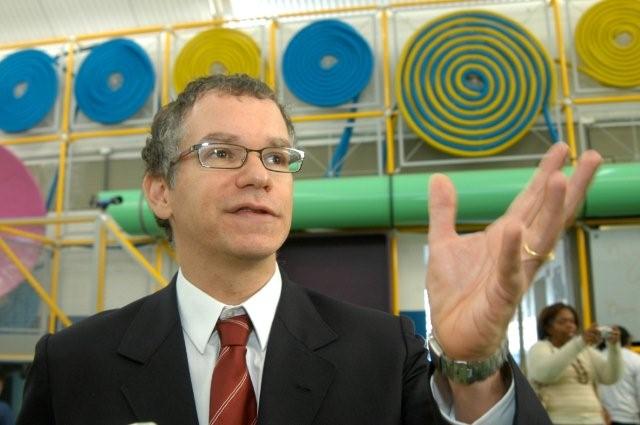
Scientific research, magnetic materials, scientific dissemination and higher education would be perhaps the biggest expressions in a cloud of tags to represent Professor Marcelo Knobel.
Born in Buenos Aires (Argentina) in 1968, Marcelo Knobel came to live in Brazil, more specifically in Campinas (SP), by the age of 8 years-old, following his parents, the psychologist Clara Freud de Knobel and the psychiatrist Maurício Knobel. The family was escaping from the coup d’etat that had just established in Argentina a military dictatorship that fired Maurício from the University of Buenos Aires (UBA). In Brazil, which was also governed by a military dictatorship, Maurício had been contracted for the State University of Campinas (Unicamp).
Ten years after the arrival in Campinas, Marcelo Knobel joined Unicamp to a graduation in Physics. In parallel to the studies, he started to do research on magnetic properties of materials. After he obtained the bachelor´s degree, Knobel remained in Unicamp for the doctorate in the same area, receiving the diploma of doctor in Physics when he defended his dissertation on magnetism and structure of nanocrystalline materials in 1992. After that, he went to Europe, where he conducted two postdoctoral internships; one at Istituto Elettrotecnico Nazionale Galileo Ferraris, Italy, and the other at the Instituto de Magnetismo Aplicado, Spain.
Returning to Brazil and to Unicamp, in 1995, Marcelo Knobel started his career of professor and researcher of the Institute of Physics Gleb Wataghin (IFGW). From 1999 to 2009 he was the coordinator of the Laboratory of Materials and Low Temperatures, where he acts as researcher until the present moment, always investigating magnetism and magnetic materials. Together with his collaborators of the laboratory, Knobel have carried pioneering works in the study of the giant magnetoresistance and magnetoimpedance in certain materials – two different concepts that are related to the opposition that a material offers to the passage of the electricity in consequence of the application of an external magnetic field. In 2008, Knobel became Full Professor of the Department of Condensed Matter Physics at IFGW.
In the area of scientific dissemination, Marcelo Knobel started in the year 2000 to perform education and research activities at the Laboratory of Advanced Studies in Journalism (LABJOR) of Unicamp. Moreover, Knobel was one of the creators of NanoAventura, an interactive and itinerary exposition on nanotechnology that started in 2005 and was visited by more than 50 thousand people, mainly children, until now. NanoAventura received honorable mentions at Scientific Cine and Video Festival of Mercosur (2006) and at Mercosur Science and Technology Award (2015), as well as an award in 2009, from the Latin American and Caribbean Network for the Popularization of Science and Technology (RedPOP). From 2006 to 2008, Knobel was the first director of the Exploratory Museum of Science, linked to Unicamp. In 2008, he became editor in chief of the magazine Ciência & Cultura of the Brazilian Society for the Progress of Science (SBPC), position that he occupies until now. In the publishing field, Knobel coordinates a collection of science dissemination books of the Unicamp Publisher, called Meio de Cultura, released in 2008.
In 2007 Marcelo Knobel received the Young Scientist Prize from the TWAS-ROLAC (office of Latin America and the Caribbean of the The World Academy of Sciences for the advancement of science in developing countries), an awars for young scientists of the region. In the same year, he was selected, together with about 50 people of different professional areas and several countries of the world, to participate of the program Eisenhower Fellowships, which aims to strengthen the leadership potential of its fellows. The group travelled for the United States during 7 weeks complying with a schedule of meetings and seminars. In 2009, he was chosen as a fellow of John Simon Guggenheim Memorial Foundation, receiving resources for research.
From 2009 to 2013, he was Vice-President for Undergraduate Programs of Unicamp. In this position, he was responsible for the implantation of the Interdisciplinary Program of Higher Education (ProFIS). ProFIS is a higher education course of 4 semesters that provides a general, multidisciplinary and critical formation, and makes possible to its alumni (former students of public schools chosen by their good grades in the Brazilian National Exam of the Secondary School (ENEM) that they enter graduation courses at Unicamp without passing for Brazilian admission university exam). The program was distinguished in 2013 with the Prize Péter Murányi – Education, destined to actions that increase well-being of populations of the south hemisphere.
In 2010, with 42 years-old, Knobel was honored with the title of Commendatore of the Order of the Scientific Merit by the Brazilian Presidency of the Republic.
Holder of a productivity scholarship 1A (the highest) at CNPq, Marcelo Knobel has published about 300 scientific articles in peer-review international journals and 15 chapters of books on magnetic materials and properties, popularization of science, public perception of science and higher education. Also he is the author of articles about science and education published in diverse medias. He has 6.370 citations, according to Google Scholar.
Marcelo Knobel had just assumed, in August 3rd, the position of director of the Brazilian National Laboratory of Nanotechnology (LNNano), of the National Center of Research in Energy and Materiais (CNPEM).
Here follows a brief interview with the scientist.
SBPMat newsletter: – Tell us what made you become a researcher and work in the field of Materials.
Marcelo Knobel: – I chose the area of Physics because of the curiosity, without knowing exactly what this meant. But already in the first semester I realized that it was what I wanted for my life, to try to understand the nature. Early in the beginning of the graduation, I had a laboratory class with professor Reiko Sato, who later invited me to do scientific initiation in her laboratory. She worked with magnetic properties of amorphous metals, and that was the subject of my research. Later, I went to the doctorate also with her, already working with nanocrystals, and later I followed the postdoctoral in the same area.
SBPMat newsletter: – Which are, in your own evaluation, your main contributions to the field of Materials?
Marcelo Knobel: – I am acting in nanoscopic magnetic systems, mainly investigating dipole interactions in magnetic nanosystems, using several experimental techniques, theoretical models and computational simulations. These systems, beyond the interest in basic research, have many possible applications, mainly in systems of magnetic record and nanomedicine. The research group that I helped to consolidate develops new nanocrystalline materials and carries studies through the development of new magnetic, structural and transport techniques. In the scope of these researches, we were pioneer in the study of giant magnetoresistance in granular systems and in the research of giant magnetoimpedance in amorphous and nanocrystalline wires and ribbons. But I have also been dedicating myself to scientific dissemination, being one of the responsible for the creation of the Exploratory Museum of Sciences of Unicamp. I was the coordinator of NanoAventura project, which is an interactive and itinerary exhibit on nanoscience and nanotechnology for children and adolescents. I still work in research in the area of public perception of science, I coordinate the series “Meio de Cultura” of Unicamp Publisher and I act as an editor in chief of the magazine Ciência & Cultura, of SBPC. Recently, I was Vice-President for Undergraduate Programs of Unicamp, where I highlight the implantation of the Interdisciplinary Program of Higher Education (ProFIS). Currently, I am initiating a new challenge, as Director of the National Laboratory of Nanotechnology (LNNano).
SBPMat newsletter: – You have an especially strong performance in dissemination of science and scientific culture. Comment with our readers, students and researchers, which is, for you, the importance to carry through this type of activity.
Marcelo Knobel: – I became a scientist after reading books and magazines of dissemination and visiting museums of sciences. I believe that we must stimulate the new generations to think critically, to have curiosity, to search to unmask the mysteries that surround them. For Brazil it is basic to stimulate young talents for science. Without them we will not have a future… Moreover, it is our obligation to give account to the society, which is the financer of the scientific research in public universities and research institutes. It is important to show the science that is done in our country, and the importance to follow investing, more and more, in science and technology.
SBPMat newsletter: – If you want, you can leave a message for the readers that are initiating their scientific careers.
Marcelo Knobel: – I do not have doubts that it is the passion that must guide the careers of everybody, and mainly of the scientists. But beyond the passion, a solid formation is necessary, not only in the specific content, but also in personal abilities, as work in team, communication (including Portuguese and English, scientific writing) and general knowledge. The scientific activity demands effort and devotion, but we are rewarded, I guess, with a life full of new challenges and opportunities.
Paper: Annealing effects on the microwave linewidth broadening of FeCuNbSiB ferromagnetic films. Alves, M.J.P.; Gonzalez-Chavez, D. E.; Bohn, F.; Sommer, R. L. Journal of Applied Physics. 117, 123913(2015) DOI: 10.1063/1.4915330.
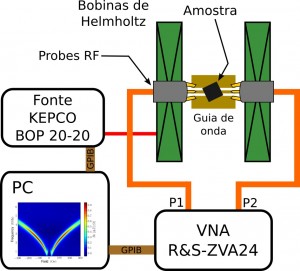
A team of scientists from the Brazilian Center for Research in Physics (CBPF) and the Federal University of Rio Grande do Norte (UFRN) conducted a study on magnetic properties of thin films made of a nanocrystalline material (i.e, formed by nanometric grains) type FINEMET. The conclusions of this scientific research can help produce high quality magnetic materials suitable for use in small-sized devices, such as magnetic random access memories (MRAMs) or nano-oscillators. Results of the study were reported in a recent article in the Journal of Applied Physics.
FINEMET type materials are alloys based on iron (Fe), silicon (Si) and boron (B) with small additions of copper (Cu) and niobium (Nb). They have very good magnetic properties when they are produced by rapid cooling followed by annealing. However, there is not yet an established route that allows obtaining the material having these properties in the form of thin films, which are better suited for miniaturized applications.
In the work of the Brazilian team, magnetic thin films FeCuNbSiB were synthesized at CBPF by scientists from UFRN and CBPF. Samples of the film were analyzed using various techniques such as grazing incidence X-ray diffraction, magnetometry and, in particular, broadband ferromagnetic resonance (FMR). “We explored this technique to the limit,” said Rubem L. Sommer, one of authors of the Journal of Applied Physics paper. “It is powerful and has allowed the study of nanostructured materials with great efficiency,” added the CBPF researcher. Sommer and his team have been contributing to the development of broadband ferromagnetic resonance technique since 2011.
The ferromagnetic resonance technique is used to study the magnetization of the material, measuring the amount of electromagnetic radiation in the microwave range that a particular material absorbs. In the conventional version of this technique, explains Sommer, this absorption is measured at a fixed frequency, and the external magnetic field is varied to tune the equipment in resonance. In the microwave range, the frequency may be between 300 MHz and 300 GHz, and 1 Hz equals 1 oscillation per second. “In the case of ferromagnetic resonance broadband, we scan frequency and the external field, making a direct mapping of the material dispersion relation,” explains Sommer.
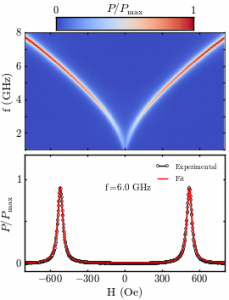
Based on the combination of the films analyses obtained by the various techniques, the team of scientists unveiled the mechanisms that are responsible for broadening the ferromagnetic resonance linewidht in the material. “The thinner the resonance line, the higher the quality of the material for applications”, said Sommer. The scientists could conclude that the residual stresses (those who remain in the materials after the elimination of their causes) were causing the enlargement of the resonance linewidth, and that annealing reduced these tensions.
The study reported in the article was funded by Brazilian agencies CNPq and CAPES and was developed mainly in the doctoral research of Marcos Alves held in CBPF and recently defended. The doctoral dissertation of Diego González-Chávez, defended in 2013, was also important for the article, as it allowed the successful development of the broadband FMR technique.
The authors of the article are part of a larger network of collaboration that includes, in addition to researchers from CBPF and UFRN, contributors from PUC-Rio and the federal universities of Santa Maria (UFSM) and Rio Grande do Sul (UFRGS), says Sommer. “I believe that this work, as well as the performance of a network spread over different institutions is a very positive aspect of the current Brazilian scientific and technological research reality”, he said. The network develops research on nanostructured materials and magnetic devices for use at high frequencies. “Our research has always a double bias: basic research to understand the phenomena and application development,” said Sommer.
Scheme of ferromagnetic resonance equipment used in broadband research. The Kepco source feeds the magnetizing circuit (Helmholtz coils) and the signal is measured with a vector Network Analyzer (VNA). The sample is placed on a coplanar waveguide with micrometric dimensions.
Results typical broadband of FMR: microwave absorption curve (color) depending on the field and frequency.